Detailed instructions: how to grow onions from A to Z
When growing onions, even an experienced summer resident can violate the rules of crop rotation and forget about timely feeding or disinfection of the sets. A beginner will make mistakes due to ignorance of the rules for growing crops. Therefore, we will tell you what kind of soil onions like and how to grow them from “a” to “z” - from preparing the land, processing and landings sowing before harvest.
How to grow onions
To obtain a good harvest, vegetable growers follow certain methods for growing onions, taking into account its nutritional needs, requirements for soil composition, lighting, and humidity levels.
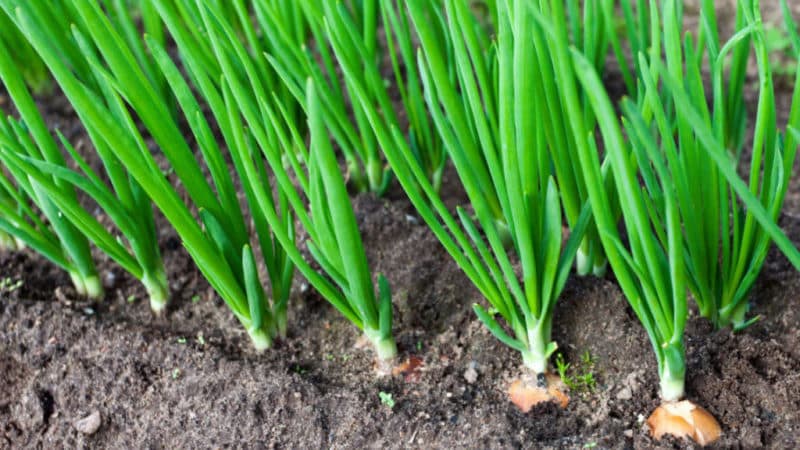
Onion likes:
- soil fertilized with organic matter, neutral in acidity;
- nitrogen and potassium at the beginning of the growing season;
- loose, air-saturated soil;
- sunny, well-ventilated areas;
- moist soil during the feather growth period and dry soil during the head growth phase.
Choosing a site for planting
Choose well-warmed and ventilated sunny areas for the beds, where the snow melts early in the spring. Groundwater should not pass close to the soil surface. The crop loves well-fertilized soil, so a site that received a large amount of fertilizer in the previous year is suitable. Follow the principles of crop rotation.
Predecessors
The best predecessor crops for onions are pumpkin (zucchini, cucumbers), cabbage, beets, salads, tomatoes, legumes (peas, beans), cereals (except oats), green manure.
Do not plant onions after garlic, carrots, herbs, or strawberries. It can be grown in the same place only after four years.
Preparation and formation of beds
Start preparing the ground for spring landings onions in the fall. This agricultural technique will help disinfect the soil. Fertilizers will be evenly distributed as the snow melts and will not damage the delicate roots of the onion set at the beginning of its growth.
Soil preparation
Apply fertilizers to the soil at the rate of 2/3 of the norm and 1/3 in the spring. Give preference to a mixture of humus and rotted manure (5-6 kg per 1 sq. m.) or use mineral fertilizers: per 1 sq. m. m 20 g superphosphate, 15 g potassium chloride, 10 g urea.
If the soil is acidic, add wood ash (0.5 kg per 1 sq. m).
Dig up the soil onto the bayonet of the shovel. Make beds, but do not level their surface. This way the ground will freeze more, and many pathogenic organisms will die. On heavily contaminated soils, this method of disease control is not enough.
Tilling the land before planting
Disinfect the soil in one of two ways:
- Prepare a solution of copper sulfate at the rate of 1 tbsp. l per 10 liters of water and pour it over the soil (2 liters per 1 sq. m.). It is possible to treat the soil in one area in this way only once every 5 years, since copper sulfate in high concentrations becomes toxic.
- Spill the soil with a solution of potassium permanganate (at the rate of 3 g per 1 liter of water).
Loosen the soil at least 10 cm, level and compact the surface of the bed.
Important! If the site is in a lowland, make high beds to prevent the onion heads from rotting.
Preparing and processing onions before planting
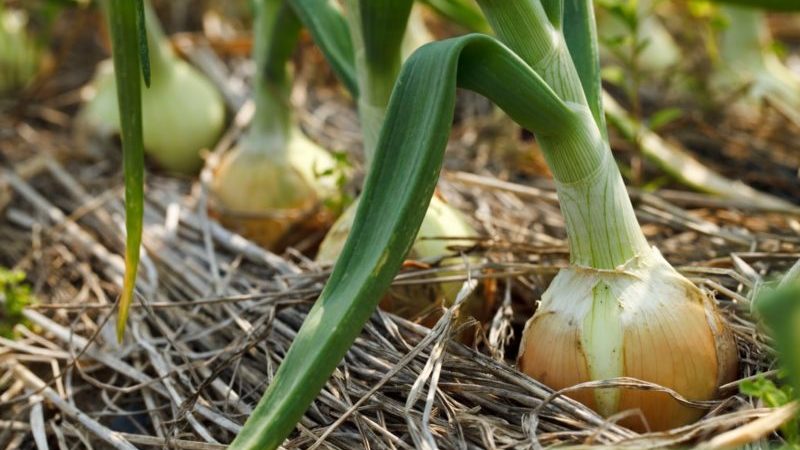
Pre-sowing treatment of seedlings is carried out with the aim of disinfecting seed material, preventing the occurrence of diseases and pest damage, and reducing bolting.
Onions are soaked and treated with solutions immediately before planting. Dry heating begins 2-3 weeks before.
What to process
Choose a treatment agent depending on the purpose: disinfection, nutrition, repelling pests. Some drugs and growth stimulants help solve several problems at the same time.
"Fitosporin"
A microbiological preparation based on Bacillus subtilis will prevent the development of bacteriosis, rot, and downy mildew.
A solution for soaking onions is prepared depending on the form of release of the drug. For dilution, use warm filtered water, and then store the solution in a dark place:
- Dilute the powder in a proportion of 10 g per 0.5 liter of water.
- Prepare a concentrate from the paste in a proportion of 100 g per 0.2 liter of warm water. Next, measure 30 ml of the resulting solution and mix it with 200 ml of water.
- Liquid – 5 drops – dilute in 100 ml of water.
Soak the seeds in any of the solutions listed for 2 hours before planting.
Potassium permangantsovka
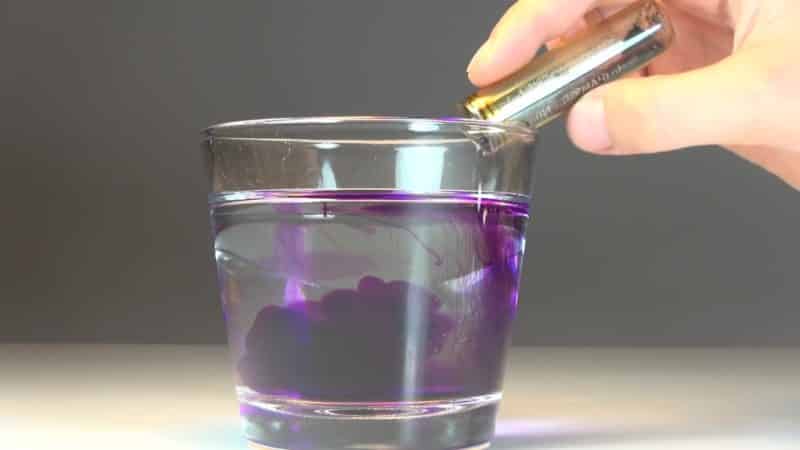
Increases crop resistance to fungal diseases and has disinfecting properties.
Dissolve 1-3 g of potassium permanganate in 1 liter of warm water and soak the onion for 30-40 minutes. Do not wash or dry before planting.
Salt or soda solution
Solutions of soda and salt are time-tested antiseptics. They prevent the development of root rot and downy mildew.
To disinfect seedlings:
- dissolve 25 g of soda in 5 liters of water, heat to +45°C and soak the seeds in it for 20-30 minutes;
- mix 10 g of salt and 1 liter of water heated to +45°C, soak the onion for 15-20 minutes.
Copper sulfate
This is one of the most powerful antiseptics with antifungal and antibacterial properties.
Important! In large concentrations, copper sulfate is poisonous.
Dissolve 30 g of powder in 10 liters of warm water. Immerse the seedlings in the mixture for 2-3 hours, then dry them, and then plant them in the ground.
Ash
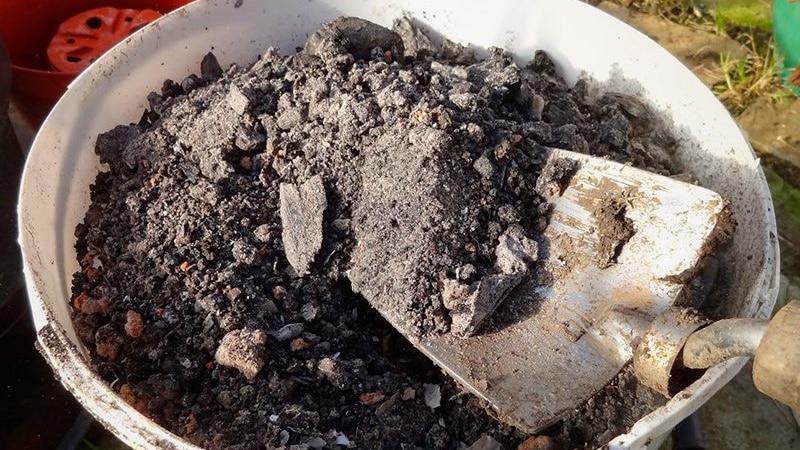
Wood ash will protect against rot and prevent the appearance of pathogenic microflora. In addition, the ash solution simultaneously serves as a nutrient for the bulbs.
Dissolve 250 g of wood ash in 5 liters of water and leave for an hour. Immerse the seed in it for 5-7 minutes, then dry in the open air for 2-3 hours.
"Epin-extra"
It is a popular adaptogen and growth stimulant. It helps withstand adverse weather conditions and enhances the development of roots and greenery.
Dilute 5 drops of Epin in 0.5 liters of water, immerse the onion in it for 10-15 minutes, then immediately plant it in the ground.
Ammonium nitrate
This is not only a disinfectant, but also a nitrogen fertilizer for the plant. Use 3 g of ammonium nitrate per 10 liters of warm water (+40°C). Immerse the onion sets in the solution for 15-20 minutes.
Birch tar
Tar prevents the development of fungal and bacterial diseases, repels onion fly.
Take 1 tbsp. l. birch tar and dissolve it in 1 liter of warm water. Soak the onion in this mixture for 2-3 hours, stir the solution periodically.
Kerosene
Kerosene is used to repel onion flies and other pests. Treat the surface of the bulbs with a solution at the rate of 1 tbsp. l. kerosene per 5 liters of water. There is no need to soak the sets in this composition.
Other preparation methods
After purchasing seed material, immediately begin preparing the onions for planting.
Sorting and drying
Inspect the set: its husk should be dry and evenly colored. Discard bulbs with signs of rot, spots, or dried out specimens.
Dry at a temperature of at least +20°C for 2-3 weeks.
Warming up so that the bow does not go into the arrow
Warm up the seed near a heating device for 10 hours at a temperature of 35-40°C. This will significantly reduce the likelihood of onions bolting and the possibility of powdery mildew infection.
Hardening
Place the seeds for 15 minutes in water at a temperature of +50°C, then in cold water for the same time. Hardening will allow onions to better adapt to temperature changes when planted in the ground and increase immunity. After the procedure, treat the onion with a growth stimulator.
Soak
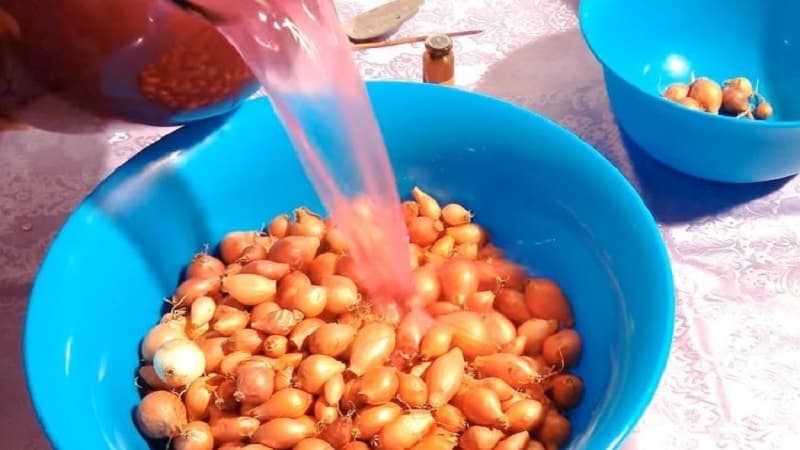
Soaking helps the roots of the sets to awaken faster, so it is carried out immediately before planting the bulbs in the ground. For soaking, use a disinfectant or nutrient solution prepared on the basis of biological preparations and chemicals.
Trimming
Carefully cut off the dry tail of the set without touching the bulb itself. Thanks to this, shoots will appear faster.
Landing technology
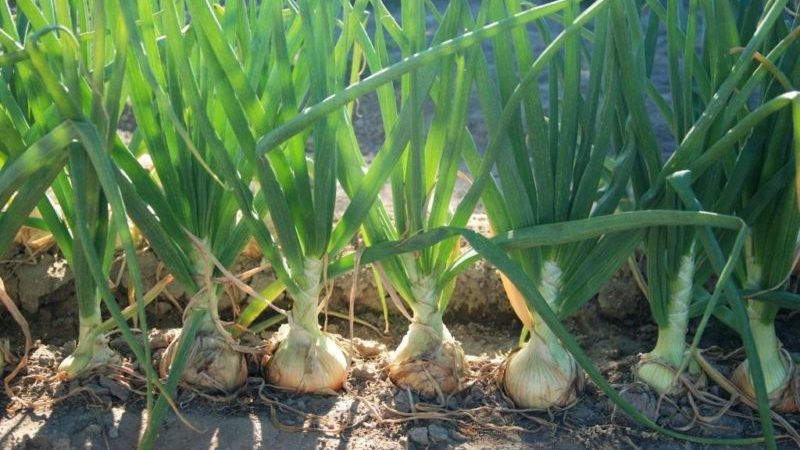
Planting onions is possible in late autumn or early spring. In practice, spring planting is more often used.
How to grow onions depending on the region and variety
The optimal temperature for warming up the soil for planting crops in open ground in the spring is +10...+12°C at a depth of 10 cm, when the threat of frost has passed.
Important! If the onion does not take root in the event of return spring frosts, it will shoot out arrows.
The planting time depends on the region where the crop is grown:
- In the southern regions this is the second ten days of April.The south of Russia is characterized by long daylight hours and warm summers, so sweet late onion varieties (Globo, Exhibition, Kaba) are suitable for cultivation. Mid-season sharp and semi-sharp varieties (Chalcedony, Globus) also grow well.
- In central Russia and the Moscow region, the planting date is the third ten days of April. Summer is shorter here, so southern varieties will not ripen. Give preference to early (Stuttgarter Riesen, Red Baron) and mid-season semi-sharp varieties (Sturon, Setton, zoned Strigunovsky, Myachkovsky). But late onions will not have time to ripen here.
- In the northern regions, Siberia and the Urals, the first ten days of May are most suitable for planting. Choose frost-resistant, spicy early and mid-early varieties (Hercules, Radar, Centurion).
Landing scheme and rules
Moisten the garden bed thoroughly. If the soil is moist enough when planting early in spring, there is no need to water it.
Most often, onions are planted on turnips in rows. Level the bed, make grooves 3-4 cm deep at a distance of 20-25 cm from each other. Pour a little ash into them.
Depth, distance from each other
The spacing between bulbs in a row depends on the size of the planting material. For wild oats with a diameter of 1 cm, 5-6 cm will be optimal, for sets with a diameter of 1-2.5 cm - 7-10 cm. Planting depth - 3-4 cm.
Arrange the bulbs in rows so that the neck is slightly below the soil surface. Cover the seedlings with soil and water.
Features of cultivation and care
Caring for onions is easy. By following the basic growing rules, you will get a good harvest.
Watering mode
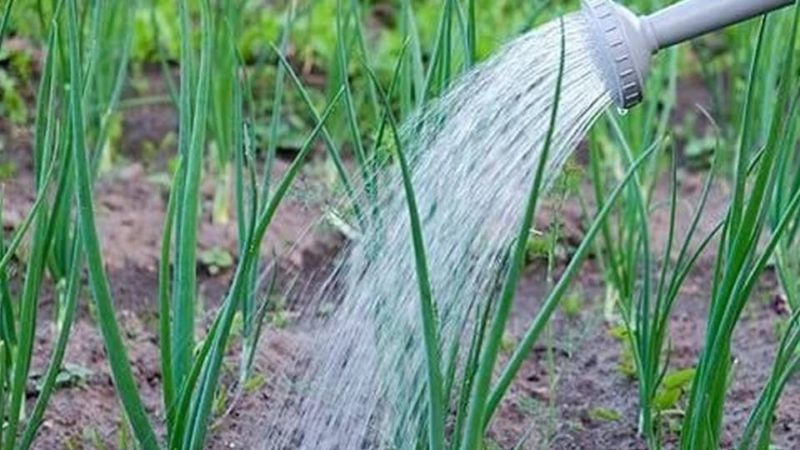
When watering, focus on soil moisture. Use warm water.
After disembarkation water sowing every 2-3 days.During the active phase of feather growth, irrigate 1-2 times a week, depending on the weather.
Reduce watering to once every 2.5 weeks when lodging of the tops begins. This means that growth processes move from the feather to the bulb. Excessive moisture will slow down the ripening process.
When the feathers begin to yellow, stop watering.
Loosening the soil and weeding
Good soil aeration is important for onions, so loosen and weed regularly. It is advisable to do this after each watering. Avoid the formation of an earthen crust that impedes air exchange.
Weeds with high soil moisture and cold weather will provoke the development of fungal and bacterial diseases.
Top dressing
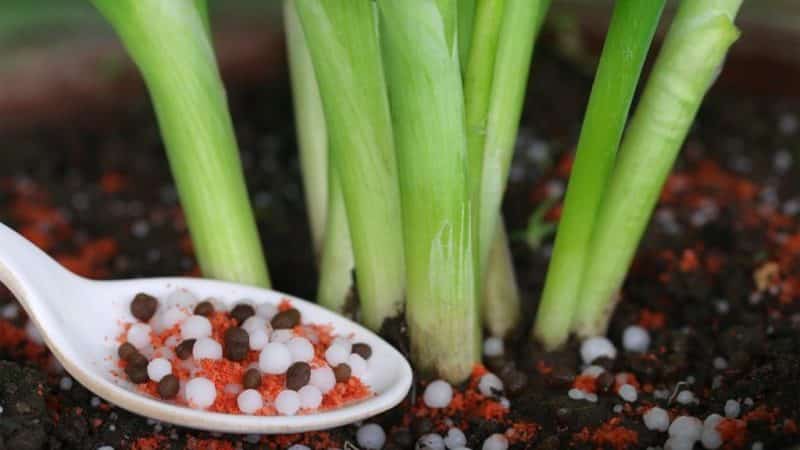
Apply fertilizing 2-3 times per season depending on soil fertility.
Apply nitrogen-containing organic or mineral fertilizers to the onion beds for the first time, approximately 10-15 days after planting:
- Leave the manure solution (in a ratio of 1:10) for 10 days, then dilute it another 10 times.
- Dilute the infusion of bird droppings (in a ratio of 1:25) aged 2 weeks 5 times. Use solutions at the rate of 3 liters per 1 sq. m.
- For mineral fertilizers, use a composition of 10-12 g of urea, 40 g of phosphorus and 20 g of potassium per 10 liters of water.
If the feather is a rich green color, thick, strong, you don’t need to fertilize it.
The second and third time, apply only potassium-phosphorus fertilizers.
Pest and disease control
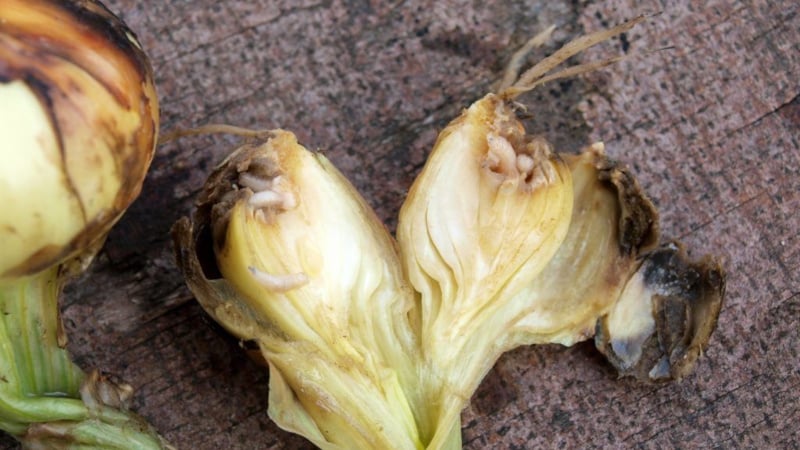
To prevent diseases, treat plants and soil with biological products (“Fitosporin”, “Trichodermin”, “Planriz”). Determine the concentration and dosage according to the instructions.
Carry out treatments at least 3-5 times during the growing season in the morning.
Treat the beds with a solution of 5-8 g of laundry soap and 15-20 g of copper sulfate, diluted in 10 liters of water.
When pests appear, use insecticides (Bitoxibacillin, Actofit, Fitoverm).
How to get a good harvest
To get a good harvest of onions:
- Organize proper watering of the beds. For onion growth, it is important that the layer of soil at a depth of 10 cm remains evenly moistened.
- Regularly after rain or watering, loosen and weed the soil.
- Feed the plants on time. Keep in mind that excess nitrogen in the soil will stimulate feather growth and the head will grow small.
- At the first signs of damage, treat the plantings to prevent diseases and destroy pests.
Harvesting and preparing onions for storage
Harvesting in central Russia begins in mid-August.
Important! If the harvest is not harvested on time, the heads will take root in damp soil and the feather will begin to grow. This harvest takes a long time stored will not be.
The following signs indicate the ripening of the head: the necks of the onions have softened, the feathers have fallen down and begun to dry, the husks have become hard and acquired a color characteristic of the variety.
Start harvesting:
- In dry weather, carefully pull the onions out of the soil.
- Dry it outside or in a well-ventilated area for 7-14 days (depending on weather and humidity levels).
- Sort out damaged bulbs with signs of disease.
- Trim the dried stems at a distance of 4 cm from the neck or braid them.
- Before cleaning storage dry the onion at a temperature of about +35°C. The better it dries, the longer it will be stored.
Tips and tricks
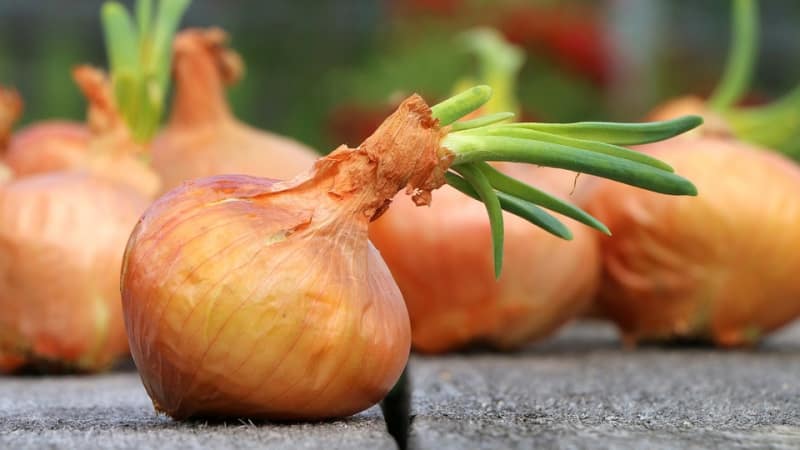
To avoid making mistakes when growing, listen to the advice and recommendations of experienced gardeners:
- Plant the sets early so that by the time the onion fly first emerges (this time coincides with the flowering of dandelions), the necks of the growing feathers are stronger. This will reduce the risk of infection of the tops by fly larvae.
- Do not bend the tops to the ground to speed up the ripening of the crop. After this, the heads rot, and harvest is under threat.
- Do not hill onions - this slows down the growth of the bulbs.
- To protect the bulbs from drying out in the heat, mulch the beds with straw, hay or humus. This will reduce the frequency of weeding and loosening and retain moisture.
Conclusion
When growing onions for turnips, the needs of the crop are taken into account, the soil and planting material are prepared. Proper plant care includes optimal watering, timely fertilizing and loosening, and disease control. Compliance with these rules will allow you to get a rich harvest of large onions for long-term storage.